In the bustling streets of Bangalore, amidst the cacophony of honking vehicles and vibrant market stalls, lies a quaint café that tells a story of transformation. Radhika, a passionate entrepreneur, owns this gem called "Radhika Café." Her journey is one that many restaurant owners can relate to—a struggle to capture the attention of passersby and turn them into loyal customers.
Radhika’s café, nestled in a prime location, had everything a customer could desire a delectable menu, warm interiors, and excellent service. Yet, something was amiss. Despite the potential, footfall remained low, and Radhika was determined to find out why.
One evening, as the sun dipped below the horizon, she stood outside her café, observing the bustling street. It was then she realized the problem—her café's entrance was unremarkable, blending into the background rather than standing out. The entrance lacked the charm and warmth that the café itself offered. This was the distinct problem Radhika faced an uninviting entrance that failed to entice potential customers.
Radhika knew she needed a change, a way to make her café’s entrance as welcoming as the ambiance inside. That’s when she discovered the importance of a "Welcoming Entrance" solution. This concept is not just about aesthetics; it’s about creating an emotional connection from the moment customers set eyes on your establishment.
Consider this a well-thought-out entrance acts like a warm handshake, inviting guests to step inside and experience what lies beyond. For Radhika, this meant transforming her entrance into a vibrant, eye-catching space that reflected the essence of her café.
The transformation began with a splash of color. Radhika chose a lively shade for her door, complemented by a beautifully hand-painted sign that read "Welcome to Radhika Café." She adorned the entrance with potted plants, adding a touch of nature to the urban setting. Soft, ambient lighting illuminated the pathway, creating a cozy and inviting atmosphere even from a distance.
Moreover, Radhika incorporated cultural elements, adding a traditional Indian rangoli design near the entrance. This not only paid homage to her roots but also attracted attention, especially during festivals when the café participated in local celebrations.
The impact was almost immediate. Curious passersby, drawn by the welcoming aura, began to stop and inquire. Regular customers noticed the change and felt an increased sense of belonging. The inviting entrance had done more than just attract new customers; it had enhanced the overall experience for everyone who walked through the door.
Radhika’s story is not unique. Across India, countless restaurant owners face the same challenge—a great service overshadowed by an uninviting entrance. The solution lies in understanding the power of first impressions. An inviting entrance is more than a doorway; it’s a storyteller, a beacon that reflects your establishment’s personality and promises a memorable experience.
For anyone facing a similar challenge, take inspiration from Radhika. Evaluate your entrance. Is it a true reflection of what your restaurant offers? Does it stand out in a way that draws people in? Small changes can make a significant difference.
In conclusion, a welcoming entrance is an investment in your brand’s image. It solves the practical problem of low footfall by addressing the emotional need for connection and curiosity. By creating an inviting space, you not only attract customers but also start their journey with a smile.
So, the next time you walk past Radhika Café in Bangalore, take a moment to appreciate the vibrant entrance. It’s not just a door; it’s a testament to the power of a warm welcome and the transformation it can bring to any business.
SEO Optimization Tips
1. Use keywords like "welcoming entrance," "restaurant transformation," "first impression," "Radhika Café," "attract customers," and "Bangalore café."
2. Ensure keyword density is balanced throughout the content.
3. Use headings and subheadings with relevant keywords for better readability and SEO.
4. Include internal links to related articles about restaurant management or customer experience.
5. Use images with alt text that includes keywords related to the blog's topic.
Visit Vyaparify Site:
https://id.vyaparify.com/radhika-cafe 
